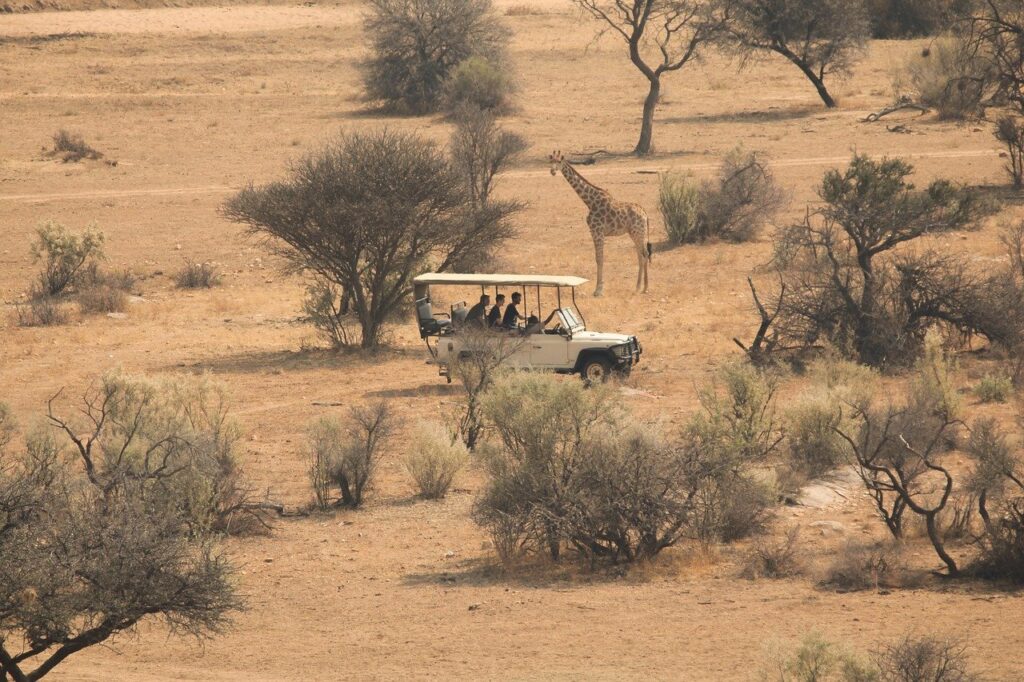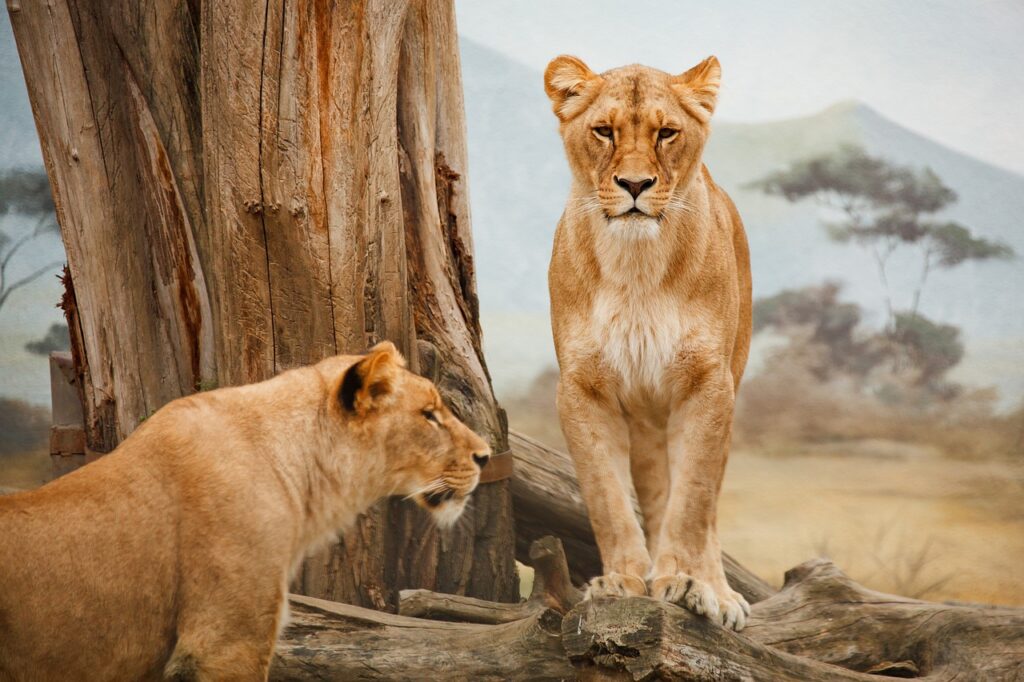The Masai Mara Ecosystem is globally recognized for its ecological diversity and significance, particularly as the host of the Great Migration and a haven for the Big Five. Located in southwestern Kenya, bordering Tanzania’s Serengeti National Park, this ecosystem spans 1,510 square kilometers within the Masai Mara National Reserve. Beyond its abundant wildlife, the Masai Mara faces significant conservation challenges, especially related to habitat degradation, climate change, and human-wildlife conflict. Below is a detailed exploration of the key ecosystems within the Masai Mara and an analysis of the conservation issues they face.
1. Savanna Grasslands: The Core of the Ecosystem
The savanna grasslands dominate most of the Masai Mara and are the core habitat for the millions of animals that migrate across the landscape annually. These grasslands, composed mainly of species like Themeda triandra (red oat grass) and Hyparrhenia species, are located in the central plains, stretching across the flat and undulating terrain that is vital for herbivores such as wildebeest, zebras, and Thomson’s gazelles.
Conservation Importance:
- Grazing Lands: The annual Great Migration is a critical event in maintaining the health of the grasslands. As wildebeest and other herbivores graze, they help control grass growth and fertilize the soil through their waste, promoting regrowth.
- Threats: Human encroachment, unsustainable tourism, and overgrazing by domestic livestock on the outskirts of the park threaten the grassland ecosystem. Land use changes and overgrazing can lead to soil degradation and loss of biodiversity.
Conservation Strategies:
- Buffer Zones: Establishing buffer zones around the Masai Mara has been critical in maintaining the balance between wildlife and human settlements. These areas act as wildlife corridors and prevent overgrazing from livestock.
- Sustainable Tourism Practices: Implementing regulations on vehicle usage during safaris and promoting eco-friendly lodges reduces the physical footprint of tourism on the fragile grasslands.
2. Riverine Forests: Life Along the Mara River
Riverine forests are found along the Mara River and its tributaries, such as the Talek River, which flow through the reserve. These areas are characterized by tall trees, such as Ficus sycomorus (sycamore fig) and Acacia xanthophloea (fever trees), creating a habitat for species like hippos, crocodiles, and leopards.
Conservation Importance:
- Biodiversity Hotspots: These forests provide crucial habitat for predators and smaller species alike, offering shelter, nesting grounds, and water sources. The Mara River itself is essential for the migration, as it serves as a crossing point for millions of migrating herbivores.
- Threats: The riverine forests face degradation due to deforestation for agriculture and overuse of water resources upstream. This negatively affects the water levels in the Mara River, impacting wildlife and reducing water availability during the dry season.
Conservation Strategies:
- Riparian Buffer Zones: Protecting and restoring riparian zones along the rivers through reforestation projects is vital to stabilizing riverbanks and maintaining water quality.
- Water Management Initiatives: Working with local communities to manage water usage in the Mara River basin can ensure sustainable water flow for wildlife and human needs, especially during the dry season.
3. Mara and Talek River Ecosystems
The Mara River is the lifeblood of the ecosystem, stretching from the Mau Forest Complex and flowing through both the Serengeti and Masai Mara. This river is a key element in the Great Migration, particularly during the dramatic river crossings where predators like crocodiles wait for migrating animals.
Conservation Importance:
- Migratory Pathways: The Mara River is essential for the survival of migrating wildebeest and zebras, providing them with drinking water and sustaining the lush vegetation along its banks during their journey.
- Hydrology and Climate Change: With the increasing impacts of climate change, irregular rainfall patterns and rising temperatures are affecting water levels, leading to periods of extreme drought or flooding, which can severely disrupt the migration.
Conservation Strategies:
- Upstream Conservation Efforts: Protecting the Mau Forest, which is the river’s source, is crucial. Deforestation upstream reduces the river’s flow, impacting the entire ecosystem downstream.
- Climate Adaptation Programs: Implementing programs aimed at understanding and mitigating the effects of climate change, such as creating artificial watering holes during extreme droughts, could help sustain wildlife.
4. Shrublands and Woodlands
Shrublands and woodlands are interspersed throughout the Masai Mara, particularly in drier areas and on the park’s hilly slopes. These ecosystems are dominated by Euphorbia candelabrum and Acacia species, providing food for browsers like giraffes and elephants.
Conservation Importance:
- Diverse Habitats: These areas support a variety of wildlife, including giraffes, dik-diks, and even leopards, which use the dense vegetation for cover. They also play a key role in carbon sequestration, making them vital in climate regulation.
- Threats: Overgrazing, charcoal production, and agricultural expansion are major threats to these ecosystems, which degrade the natural habitat and cause biodiversity loss.
Conservation Strategies:
- Reforestation and Land Rehabilitation: Reforestation efforts, particularly involving indigenous tree species, are crucial for restoring degraded areas. Protecting the remaining woodlands and expanding tree-planting programs can improve carbon storage and support biodiversity.
- Community Involvement: Local Maasai communities play an integral role in conservation efforts. Programs that encourage sustainable land use practices, such as rotational grazing and the introduction of drought-resistant crops, can reduce the pressure on these ecosystems.
5. Upland Ecosystems and the Oloololo Escarpment
The Oloololo Escarpment, located on the western edge of the Masai Mara, forms the highest point of the ecosystem. The upland areas here are characterized by a mix of grasslands and woodlands, supporting species like elephants, buffaloes, and a variety of bird species.
Conservation Importance:
- Wildlife Corridor: The escarpment acts as a natural boundary and a wildlife corridor, particularly for species migrating between the Mara Triangle and Lolgorian areas. It also offers critical refuge for animals during the dry season.
- Threats: Increasing human settlements and agricultural encroachment on the edges of the escarpment threaten its integrity, potentially blocking migration routes and increasing human-wildlife conflict.
Conservation Strategies:
- Wildlife Corridors: Establishing protected corridors to allow for the free movement of wildlife is essential. Collaborative efforts between the Mara Conservancies and local communities can help secure these critical migration routes.
- Eco-Friendly Farming: Promoting sustainable agricultural practices in the regions bordering the escarpment, such as reduced use of pesticides and controlled grazing, can minimize habitat destruction and maintain the ecosystem’s health.
Conservation Challenges and Solutions
Human-Wildlife Conflict: The expansion of agricultural activities around the Masai Mara has increased conflicts between local communities and wildlife. Elephants, lions, and hyenas often stray into farmland, causing damage to crops and livestock, which leads to retaliation killings.
- Solution: Establishing community conservancies has proven to be an effective strategy in mitigating conflict. These conservancies, such as Ol Kinyei and Naboisho, create buffer zones that allow wildlife to move freely while providing economic benefits to local Maasai communities through eco-tourism and conservation initiatives.
Tourism Pressure: The Masai Mara attracts thousands of tourists annually, particularly during the Great Migration, leading to concerns about habitat degradation from off-road driving, overcrowding at key wildlife viewing sites, and pollution.
- Solution: Promoting sustainable tourism practices, such as restricting vehicle access in sensitive areas, limiting the number of vehicles at animal sightings, and encouraging the use of eco-friendly lodges, helps mitigate the negative impact of tourism.
Tourism Impacts on the ecosystem
The extensive use of the Masai Mara for game drives has had notable ecological impacts on its delicate ecosystem. Off-road driving, which is common in pursuit of better wildlife viewing experiences, leads to soil compaction, habitat destruction, and the degradation of vegetation, particularly in sensitive areas like riverine zones and grasslands. These effects disrupt the natural grazing patterns of herbivores like wildebeest and zebras, which, in turn, affect the broader predator-prey dynamics. Overcrowding during peak tourist seasons, especially during the Great Migration, intensifies this damage.
Dust pollution, noise, and litter generated by vehicles also alter the behavior of key species such as lions, elephants, and cheetahs, which can become stressed or avoid high-traffic areas. Furthermore, the increased proximity of tourists to wildlife increases the risk of human-wildlife conflict and disease transmission. Conservation efforts have been put in place, such as limiting vehicle numbers and restricting off-road driving in certain areas, but the continued strain of high tourism pressure remains a concern for the long-term sustainability of the ecosystem.
Solutions like promoting eco-friendly tourism practices, encouraging the use of community conservancies to disperse tourist activities, and better management of traffic within the park can help mitigate these impacts while still providing high-quality safari experiences.
Conclusion
The Masai Mara Ecosystem is an ecological treasure trove, supporting a wide variety of plant and animal species. Its open savannas, riverine forests, and wetlands form the backbone of one of the most important wildlife habitats in Africa. However, this ecosystem faces significant challenges, including habitat loss, climate change, and human-wildlife conflict.
By prioritizing conservation efforts, promoting sustainable tourism, and engaging local communities in protecting this rich environment, the future of the Masai Mara can be secured. Continued research, like that of Green et. al.(2019) and conservation-driven partnerships with global and local stakeholders, is crucial to safeguarding this unique ecosystem for generations to come.



